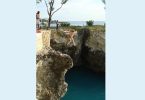Band-E-Amir National Park, Afghanistan – Big dreams are reflected in the azure-hued shimmer of these pristine mountain lakes: Afghanistan’s quixotic ambitions of becoming a tourist paradise.
With the dedication today of the country’s first national park, made up of six linked lakes rimmed with breathtaking travertine cliffs, officials voiced hopes that visitors might slowly return to Afghanistan after three decades of war.
This nation hasn’t had a place on the tourist map since the 1970s. In those days, it was a popular stop on the hippie trail, its Silk Road exoticism and cheap hashish an irresistible lure.
Nowadays, with a Taliban-led insurgency raging unabated, the State Department continues to “strongly warn U.S. citizens against travel to Afghanistan,” adding that no part of the country “should be considered immune from violence.”
Still, U.S. Ambassador Karl Eikenberry was among the dignitaries who joined in the dedication of Band-e-Amir National Park, telling an audience of VIPs and villagers gathered under a makeshift tent that the occasion marked a “proud moment for Afghanistan . . . a reawakening.”
The park lies in Bamian province, in central Afghanistan, known for the otherworldly beauty of its landscape as well as a notable lack of insurgent violence. But the province’s sunlit valleys harbor a dark past.
In 2001, the Taliban’s destruction of the giant Buddha statues of Bamian became an emblem of the movement’s repressive rule. In the late 1990s, minority Hazaras in Bamian and elsewhere were the target of ethnic bloodletting.
The creation of a national park at Band-e-Amir is the culmination of 35 years of efforts by Afghan and international groups, repeatedly derailed by war and threatened at one point by a huge proposed hydroelectric project. That was headed off largely through the efforts of the province’s strong-willed female governor, Habiba Sarabi, who was present for the dedication.
For centuries, invading armies have made up the vast majority of Afghanistan’s foreign visitors. Only a trickle of international tourists can be counted now, but Bamian has long been a steady draw for Afghan families, along with foreign aid workers and other expatriates.
“I think more and more people will come as they realize this is a very secure corner of the country,” said Sher Husain, whose hotel overlooks the empty niches where the Buddhas once stood.
As to when Afghanistan as a whole might be safe enough for the casual traveler, Eikenberry — who was a three-star Army general and a veteran of the Afghan war before taking up his ambassadorship — acknowledged, “It’s going to be some time.”
Still, the park’s scenic charms are such that they give rise to a rarity in Afghanistan: the impulse to frolic. At lakeside, the ambassador clambered into a pale blue swan-shaped pedal-powered boat and took the country’s vice president, Karim Khalili, for a spin.
Band-e-Amir is relatively inaccessible; getting here requires a bumpy 10-hour road trip through two mountain ranges from the capital, Kabul, about 110 miles to the east. A U.S.-funded road project is expected to eventually shorten that journey to three hours.
Some would be happy to see the area remain off the beaten path, fearing for its fragile ecosystem.
Marnie Gustavson, an American who runs a nonprofit organization in Kabul that works with disadvantaged Afghans, recalled visiting the lakes as a child in the 1960s with her parents, who were development workers. She described bathing in the crystalline lakes after a long, dusty journey as “magical.”
“Some tourist development is good, because it will help the local people and the local economy,” she said. “Just not too much of it.”
(eTN): Putting the country back on the tourist map | re-post license | post content






















